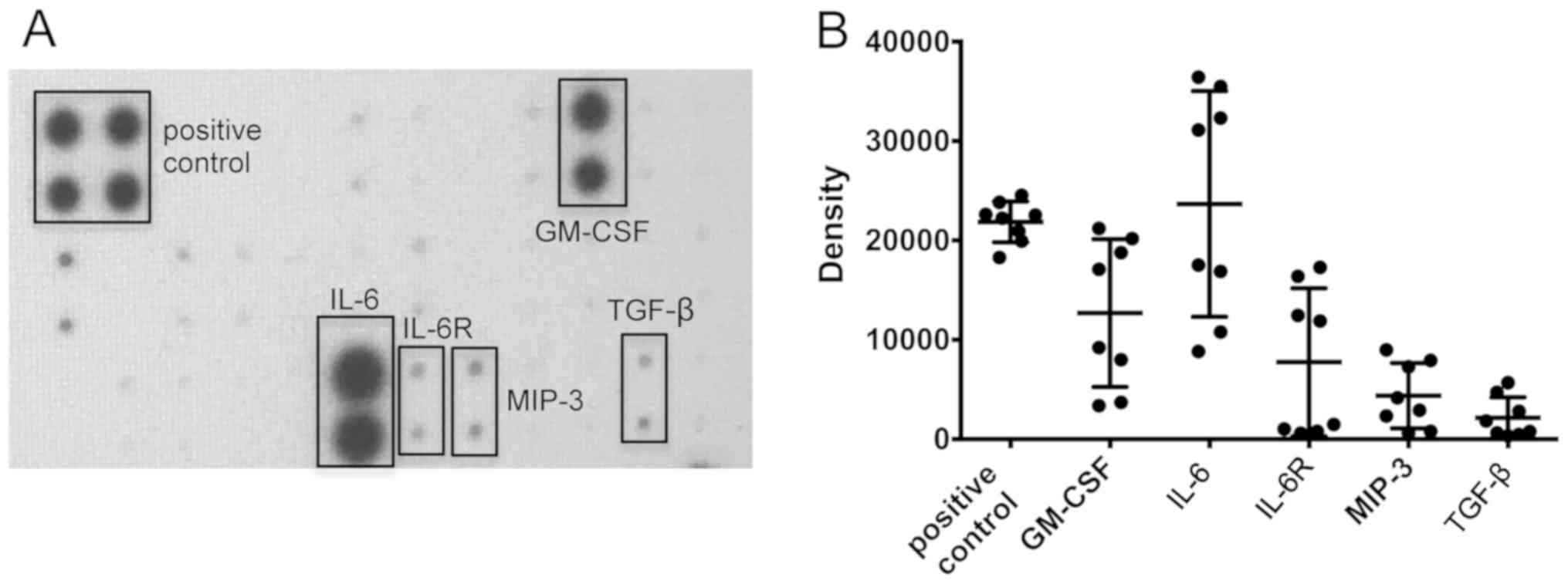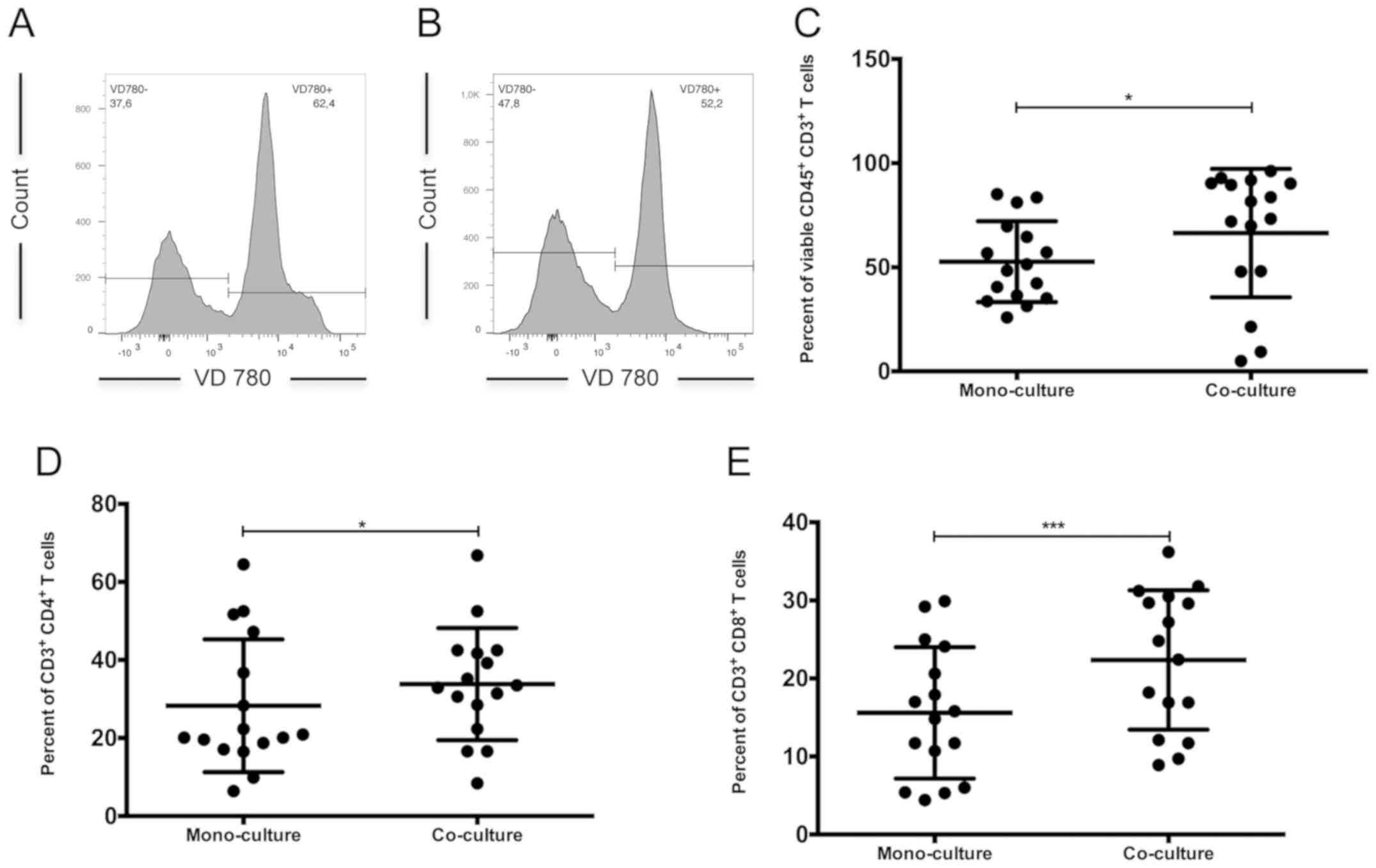|
1
|
Fokkens WJ, Lund VJ, Mullol J, Bachert C,
Alobid I, Baroody F, Cohen N, Cervin A, Douglas R, Gevaert P, et
al: European Position Paper on Rhinosinusitis and Nasal Polyps
2012. Rhinol Suppl. 23(3)2012.PubMed/NCBI
|
|
2
|
Tomassen P, Vandeplas G, Van Zele T,
Cardell LO, Arebro J, Olze H, Förster-Ruhrmann U, Kowalski ML,
Olszewska-Ziąber A, Holtappels G, et al: Inflammatory endotypes of
chronic rhinosinusitis based on cluster analysis of biomarkers. J
Allergy Clin Immunol. 137:1449–56, e4. 2016.PubMed/NCBI View Article : Google Scholar
|
|
3
|
Derycke L, Eyerich S, Van Crombruggen K,
Pérez-Novo C, Holtappels G, Deruyck N, Gevaert P and Bachert C:
Mixed T helper cell signatures in chronic rhinosinusitis with and
without polyps. PLoS One. 9(e97581)2014.PubMed/NCBI View Article : Google Scholar
|
|
4
|
Van Zele T, Claeys S, Gevaert P, Van Maele
G, Holtappels G, Van Cauwenberge P and Bachert C: Differentiation
of chronic sinus diseases by measurement of inflammatory mediators.
Allergy. 61:1280–1289. 2006.PubMed/NCBI View Article : Google Scholar
|
|
5
|
Peters AT, Kato A, Zhang N, Conley DB, Suh
L, Tancowny B, Carter D, Carr T, Radtke M, Hulse KE, et al:
Evidence for altered activity of the IL-6 pathway in chronic
rhinosinusitis with nasal polyps. J Allergy Clin Immunol.
125:397–403, e10. 2010.PubMed/NCBI View Article : Google Scholar
|
|
6
|
Ickrath P, Kleinsasser N, Ding X, Ginzkey
C, Beyersdorf N, Hagen R, Kerkau T and Hackenberg S:
Characterization of T-cell subpopulations in patients with chronic
rhinosinusitis with nasal polyposis. Allergy Rhinol (Providence).
8:139–147. 2017.PubMed/NCBI View Article : Google Scholar
|
|
7
|
Miyara M, Yoshioka Y, Kitoh A, Shima T,
Wing K, Niwa A, Parizot C, Taflin C, Heike T, Valeyre D, et al:
Functional delineation and differentiation dynamics of human CD4+ T
cells expressing the FoxP3 transcription factor. Immunity.
30:899–911. 2009.PubMed/NCBI View Article : Google Scholar
|
|
8
|
Schweinlin M, Rossi A, Lodes N, Lotz C,
Hackenberg S, Steinke M, Walles H and Groeber F: Human barrier
models for the in vitro assessment of drug delivery. Drug Deliv
Transl Res. 7:217–227. 2017.PubMed/NCBI View Article : Google Scholar
|
|
9
|
Everman JL, Rios C and Seibold MA:
Utilization of air-liquid interface cultures as an in vitro model
to assess primary airway epithelial cell responses to the type 2
cytokine interleukin-13. Methods Mol Biol. 1799:419–432.
2018.PubMed/NCBI View Article : Google Scholar
|
|
10
|
Pezzulo AA, Starner TD, Scheetz TE, Traver
GL, Tilley AE, Harvey BG, Crystal RG, McCray PB Jr and Zabner J:
The air-liquid interface and use of primary cell cultures are
important to recapitulate the transcriptional profile of in vivo
airway epithelia. Am J Physiol Lung Cell Mol Physiol. 300:L25–L31.
2011.PubMed/NCBI View Article : Google Scholar
|
|
11
|
Kesimer M, Kirkham S, Pickles RJ,
Henderson AG, Alexis NE, Demaria G, Knight D, Thornton DJ and
Sheehan JK: Tracheobronchial air-liquid interface cell culture: A
model for innate mucosal defense of the upper airways? Am J Physiol
Lung Cell Mol Physiol. 296:L92–L100. 2009.PubMed/NCBI View Article : Google Scholar
|
|
12
|
Steinbichler TB, Metzler V, Pritz C,
Riechelmann H and Dudas J: Tumor-associated fibroblast-conditioned
medium induces CDDP resistance in HNSCC cells. Oncotarget.
7:2508–2518. 2016.PubMed/NCBI View Article : Google Scholar
|
|
13
|
Juel HB, Faber C, Udsen MS, Folkersen L
and Nissen MH: Chemokine expression in retinal pigment epithelial
ARPE-19 cells in response to coculture with activated T cells.
Invest Ophthalmol Vis Sci. 53:8472–8480. 2012.PubMed/NCBI View Article : Google Scholar
|
|
14
|
Steelant B, Seys SF, Van Gerven L, Van
Woensel M, Farre R, Wawrzyniak P, Kortekaas Krohn I, Bullens DM,
Talavera K, Raap U, et al: Histamine and T helper cytokine-driven
epithelial barrier dysfunction in allergic rhinitis. J Allergy Clin
Immunol. 141:951–63, e8. 2018.PubMed/NCBI View Article : Google Scholar
|
|
15
|
Koehler C, Paulus M, Ginzkey C, Hackenberg
S, Scherzad A, Ickrath P, Hagen R and Kleinsasser N: The
Proinflammatory potential of nitrogen dioxide and its influence on
the house dust mite allergen der p 1. Int Arch Allergy Immunol.
171:27–35. 2016.PubMed/NCBI View Article : Google Scholar
|
|
16
|
Koehler C, Ginzkey C, Friehs G, Hackenberg
S, Froelich K, Scherzed A, Burghartz M, Kessler M and Kleinsasser
N: Aspects of nitrogen dioxide toxicity in environmental urban
concentrations in human nasal epithelium. Toxicol Appl Pharmacol.
245:219–225. 2010.PubMed/NCBI View Article : Google Scholar
|
|
17
|
Revenfeld AL, Steffensen R, Pugholm LH,
Jørgensen MM, Stensballe A and Varming K: Presence of HLA-DR
Molecules and HLA-DRB1 mRNA in Circulating CD4(+) T Cells. Scand J
Immunol. 84:211–221. 2016.PubMed/NCBI View Article : Google Scholar
|
|
18
|
Motamedi M, Xu L and Elahi S: Correlation
of transferrin receptor (CD71) with Ki67 expression on stimulated
human and mouse T cells: The kinetics of expression of T cell
activation markers. J Immunol Methods. 437:43–52. 2016.PubMed/NCBI View Article : Google Scholar
|
|
19
|
Yoon JH, Moon HJ, Seong JK, Kim CH, Lee
JJ, Choi JY, Song MS and Kim SH: Mucociliary differentiation
according to time in human nasal epithelial cell culture.
Differentiation. 70:77–83. 2002.PubMed/NCBI View Article : Google Scholar
|
|
20
|
Bleier BS, Mulligan RM and Schlosser RJ:
Primary human sinonasal epithelial cell culture model for topical
drug delivery in patients with chronic rhinosinusitis with nasal
polyposis. J Pharm Pharmacol. 64:449–456. 2012.PubMed/NCBI View Article : Google Scholar
|
|
21
|
de Borja Callejas F, Martínez-Antón A,
Alobid I, Fuentes M, Cortijo J, Picado C, Roca-Ferrer J and Mullol
J: Reconstituted human upper airway epithelium as 3-d in vitro
model for nasal polyposis. PLoS One. 9(e100537)2014.PubMed/NCBI View Article : Google Scholar
|
|
22
|
Divekar RD, Samant S, Rank MA, Hagan J,
Lal D, O'Brien EK and Kita H: Immunological profiling in chronic
rhinosinusitis with nasal polyps reveals distinct VEGF and GM-CSF
signatures during symptomatic exacerbations. Clin Exp Allergy.
45:767–778. 2015.PubMed/NCBI View Article : Google Scholar
|
|
23
|
Romano M, Sironi M, Toniatti C,
Polentarutti N, Fruscella P, Ghezzi P, Faggioni R, Luini W, van
Hinsbergh V, Sozzani S, et al: Role of IL-6 and its soluble
receptor in induction of chemokines and leukocyte recruitment.
Immunity. 6:315–325. 1997.PubMed/NCBI View Article : Google Scholar
|
|
24
|
Poposki JA, Uzzaman A, Nagarkar DR, Chustz
RT, Peters AT, Suh LA, Carter R, Norton J, Harris KE, Grammer LC,
et al: Increased expression of the chemokine CCL23 in eosinophilic
chronic rhinosinusitis with nasal polyps. J Allergy Clin Immunol.
128:73–81, e4. 2011.PubMed/NCBI View Article : Google Scholar
|
|
25
|
Poposki JA, Keswani A, Kim JK, Klingler
AI, Suh LA, Norton J, Carter RG, Peters AT, Hulse KE, Grammer LC,
et al: Tissue proteases convert CCL23 into potent monocyte
chemoattractants in patients with chronic rhinosinusitis. J Allergy
Clin Immunol. 137:1274–1277, e9. 2016.PubMed/NCBI View Article : Google Scholar
|
|
26
|
Van Bruaene N, Derycke L, Perez-Novo CA,
Gevaert P, Holtappels G, De Ruyck N, Cuvelier C, Van Cauwenberge P
and Bachert C: TGF-beta signaling and collagen deposition in
chronic rhinosinusitis. J Allergy Clin Immunol. 124:253–9,
259.e1-2. 2009.PubMed/NCBI View Article : Google Scholar
|
|
27
|
Pant H, Hughes A, Miljkovic D, Schembri M,
Wormald P, Macardle P, Grose R, Zola H and Krumbiegel D:
Accumulation of effector memory CD8+ T cells in nasal polyps. Am J
Rhinol Allergy. 27:e117–e126. 2013.PubMed/NCBI View Article : Google Scholar
|
|
28
|
Pham OH and McSorley SJ: Divergent
behavior of mucosal memory T cells. Mucosal Immunol. 8:731–734.
2015.PubMed/NCBI View Article : Google Scholar
|
|
29
|
Carbone FR: Tissue-resident memory T cells
and fixed immune surveillance in nonlymphoid organs. J Immunol.
195:17–22. 2015.PubMed/NCBI View Article : Google Scholar
|
|
30
|
Ely KH, Cauley LS, Roberts AD, Brennan JW,
Cookenham T and Woodland DL: Nonspecific recruitment of memory CD8+
T cells to the lung airways during respiratory virus infections. J
Immunol. 170:1423–1429. 2003.PubMed/NCBI View Article : Google Scholar
|
|
31
|
Schmitz S: Der Experimentator: Zellkultur.
Spektrum Akademischer Verlag, Heidelberg. 2011.
|
|
32
|
Gstraunthaler G and Lindl T: Zell- und
Gewebekultur: Allgemeine Grundlagen und spezielle Anwendungen.
Springer Spektrum Akademischer Verlag, Heidelberg. 2013.
|

















